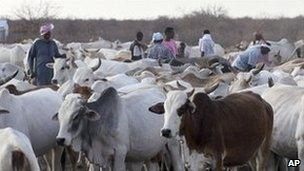Rinderpest virus has been wiped out, scientists say
- Published

The disease arrived in Africa at the end of the nineteenth century
Scientists working for the UN say that they have eradicated a virus which can be deadly to cattle.
If confirmed, rinderpest would become only the second viral disease - after smallpox - to have been eliminated by humans.
Rinderpest was once prevalent in the Middle East, Africa and Asia.
The UN's Food and Agriculture Organization (FAO) has said that it will now suspend its efforts to track and eliminate the virus.
The the virus has been eradicated from those parts of the world where it is prevalent.
When the disease arrived in Africa at the end of the nineteenth century between 80% and 90% of cattle and buffalo on the continent were killed.
The eradication of the virus has been described as the biggest achievement in veterinary history and one which will save the lives and livelihoods of millions of the poorest people in the world.
Dr John Anderson from the Institute for Animal Health (IAH) at Pirbright, UK, who has been involved with the eradication programme, said: "For too long people have been involved in controlling diseases and not actually dreaming that it is possible to eradicate a disease from the world. And with Rinderpest we did."
The latest FAO progress report on the rinderpest eradication programme said: "As of mid 2010, FAO is confident that the rinderpest virus has been eliminated from Europe, Asia, Middle East, Arabian Peninsula, and Africa."
These are the regions afflicted by the viral disease in the recent past.
A formal announcement on the eradication of rinderpest is expected to be made by the World Organisation for Animal Health (OIE) next year.
Dr Anderson and his colleagues at the IAH helped develop a simple way to test cattle to see if they had the disease.
The test, which was developed with the support of the UK's Department for International Development, was designed to be used by local people in the field and to give reliable results within minutes. It proved highly effective and the technology has been rolled out across Africa.
This was particularly important in the later stages of the programme when pockets of the virus remained in war-torn areas of southern Sudan and Somalia.
Dr Mike Baron of the IAH told “óĻó“«Ć½ News that it had been too dangerous for outsiders to enter those areas.
Experts, he said, would train locals - so called 'barefoot vets' - to recognise the disease and administer vaccines. They would work with nomadic tribesmen in the regions and vaccinate herds "on the move".
Rinderpest is one of the most lethal cattle diseases known to science. Typically, seven out of 10 cattle infected with the disease would die. But in the 1960s, veterinary scientist Walter Plowright developed a workable vaccine, allowing the disease to be brought under control.
But to begin with there was little to no co-ordination. Individual countries and groups of countries would attempt to vaccinate cattle, suppressing the disease for a while. But it would then re-appear.
Progress was only made once large unified projects were established to tackle the disease.
"It's an enormously important achievement because it highlights what can be done by people working together," Dr Baron told “óĻó“«Ć½ News.
"It has also taken a disease which has been a huge threat to the livelihood of people and removed it."
- Published15 September 2010
- Published11 September 2010